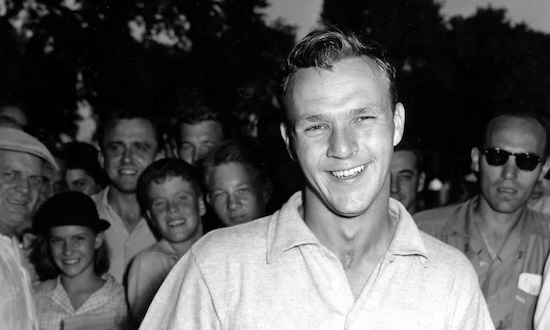Turning Point: Nearly 70 years ago, the U.S. Amateur changed Arnold Palmer's career
08 Mar 2024
by Golfweek
SHARE:

Arnold Palmer
Story by Adam Schupak and originally appeared in the May 9, 2014 issue of GolfweekHe was a 24-year-old paint salesman living in Cleveland, just seven months removed from a three-year stint in the Coast Guard. This was before his army of adoring fans, before his patented charges, and before he made golf cool.
Arnold Palmer, the son of a greenkeeper, entered the national sporting consciousness at the 1954 U.S. Amateur by defeating Robert Sweeny, 1 up, at the Country Club of Detroit.
Ask him to recount his earliest glory days and Palmer has been known to reach for a black hardcover copy of a 64-page book detailing the significance of this triumph. The cursive lettering of the title, written in gold-leaf, says it all: “The Turning Point.”
“That’s what it was in my life,” Palmer says all these years later seated in his office above the locker room at Bay Hill Club. “It gave me the confidence that I was ready to turn professional and play the PGA Tour.”
One year later, Palmer won the first of his 62 Tour titles and began to usher in golf’s modern era. But at the 54th U.S. Amateur, Palmer, who was as slender as wire and strong as cable, was a dark horse among the 1,278 entries that included Billy Jo Patton, Frank Stranahan, and Harvie Ward. Even that week, Palmer injected excitement into the championship with his high-wire act. Jimmy Gill, Palmer’s 16-year-old caddie, recalled the stir of fascination that Palmer’s go-for-broke style caused.
“If he missed the shot, he knew he would make it up later,” Gill said. “He had something about him. That walk of his, the way he attacked the ball.”
Palmer survived a daunting gantlet of foes on a par-70 course that had been stretched for the competition to 6,875 yards by Robert Trent Jones Sr. Palmer kidded USGA officials that they must have wanted him out of the tournament early.
He edged Frank Strafaci, a seven-time Met (N.Y.) amateur champion, and John Veghte, a Florida State golfer, 1 up, in the first two rounds. Then in the fifth round, just to reach the quarterfinals, Palmer faced Stranahan. “Nemesis is a good word to describe our relationship on the course,” Palmer said.
Related:
LIST: The five players to win a U.S. Amateur Championship and the Masters Tournament
Indeed, Stranahan, 32, had Palmer’s number. Previously, he smoked Palmer 12 and 11, in the 36-hole semifinal at the North and South Amateur and at the 1950 Amateur by a 4- and-3 margin. This time Palmer settled things, 3 and 1.
As the golfers walked off the green, Stranahan said to Palmer, “That’s it. I’m turning pro tomorrow.”
Next, Palmer faced Don Cherry, the 1953 Canadian Amateur champ and a crooner, who had performed the night before at the nearby Dakota Inn. As Jimmy Demaret once said to him, “Don, the golfers say you’re a singer and the singers say you’re a golfer. So what the hell are you?”
On this occasion, he was another tough out for Palmer. Cherry held a 2-up lead with seven holes to go but lost his rhythm and the match, 1 up. Afterward, Palmer phoned his parents in Latrobe, Pa., to tell them he had reached the 36-hole semifinal. They hopped into their car and drove eight hours to be there.
“That meant more to me than you can imagine,” Palmer said.
You can view the rest of the story on Golfweek.com